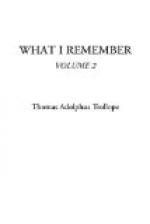And so exeunt from the sight of men and from history a Grand Duke and a Grand Duchy.
CHAPTER VII.
It was not long after the flood in Florence—it seems to me, as I write, that I might almost leave out the two last words!—that I saw Dickens for the first time. One morning in Casa Berti my mother was most agreeably surprised by a card brought in to her with “Mr. and Mrs. Charles Dickens” on it. We had been among his heartiest admirers from the early days of Pickwick. I don’t think we had happened to see the Sketches by Boz. But my uncle Milton used to come to Hadley full of “the last Pickwick,” and swearing that each number out-Pickwicked Pickwick. And it was with the greatest curiosity and interest that we saw the creator of all this enjoyment enter in the flesh.
We were at first disappointed, and disposed to imagine there must be some mistake! No! that is not the man who wrote Pickwick! What we saw was a dandified, pretty-boy-looking sort of figure, singularly young looking, I thought, with a slight flavour of the whipper-snapper genus of humanity.
Here is Carlyle’s description of his appearance at about that period of his life, quoted from Froude’s History of Carlyle’s Life in London:
“He is a fine little fellow—Boz—I think. Clear blue, intelligent eyes, eyebrows that he arches amazingly, large, protrusive, rather loose mouth, a face of most extreme mobility, which he shuttles about—eyebrows, eyes, mouth and all—in a very singular manner when speaking. Surmount this with a loose coil of common-coloured hair, and set it on a small compact figure, very small, and dressed a la D’Orsay rather than well—this is Pickwick. For the rest, a quiet, shrewd-looking little fellow, who seems to guess pretty well what he is and what others are.”
One may perhaps venture to suppose that had the second of these guesses been less accurate, the description might have been a less kindly one.
But there are two errors to be noted in this sketch, graphic as it is. Firstly, Dickens’s eyes were not blue, but of a very distinct and brilliant hazel—the colour traditionally assigned to Shakspeare’s eyes. Secondly, Dickens, although truly of a slight, compact figure, was not a very small man. I do not think he was below the average middle height. I speak from my remembrance of him at a later day, when I had become intimate with him; but curiously enough, I find on looking back into my memory, that if I had been asked to describe him, as I first saw him, I too should have said that he was very small. Carlyle’s words refer to Dickens’s youth soon after he had published Pickwick; and no doubt at this period he had a look of delicacy, almost of effeminacy, if one may accept Maclise’s well-known portrait as a truthful record, which might give those who saw him the impression of his being smaller and more fragile in build than was the fact. In later life he lost this D’Orsay look completely, and was bronzed and reddened by wind and weather like a seaman.




